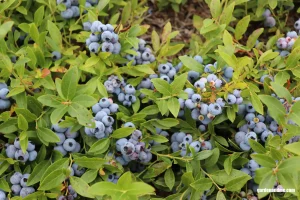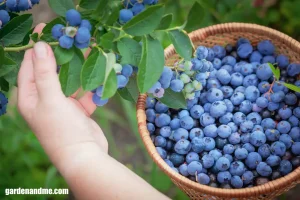Blueberries are delicious and versatile fruits cherished for their sweet-tart flavor and numerous health benefits. If you’re a blueberry lover, you may wonder when blueberry season typically occurs, how to grow your blueberries, and how to incorporate them into your favorite recipes. In this article, we will explore all these topics and more.

Blueberry types and when is the blueberry season?
Blueberry season
Blueberries typically come into season in late March or early April, depending on the region. The blueberry bushes bloom as the weather warms up, and the berries gradually ripen over several weeks.
The duration of the blueberry season varies depending on the region and the specific variety of blueberries being grown. Blueberry season generally lasts a few months, from late spring to early summer.
Blueberries are grown across the United States, with different regions having blueberry seasons. For example, Florida has the earliest harvest, while states like Michigan produce blueberries later in the season. Blueberries are also native to North America and can grow wild in certain areas.
Types of blueberry
There are several different cultivars of blueberries, each with its unique characteristics. The most popular varieties include high bush, low bush, and rabbit eye blueberries. High bush blueberries are the most common type grown commercially, while low bush blueberries are typically used for wild harvesting. Rabbit eye blueberries are well-suited to warmer climates.
Wild blueberries grow in certain regions, particularly in acidic soils and cooler climates. These wild blueberries are smaller but are known for their intense flavor.
Growing Blueberry
Blueberries prefer a climate with cool winters and moderate summers. They are easy to grow in regions with a short growing season, as they require a certain amount of chilling hours (below 45 degrees Fahrenheit) during the winter to break dormancy and set fruit. However, different varieties of blueberries, including high bush and rabbit eye, are adapted to a range of climates.
Here is the step to grow blueberry from seeds:
1. Obtain fresh seeds: Blueberry seeds can be collected by harvesting ripe blueberries and extracting the seeds from within the fruit. Make sure to select ripe, healthy berries for best results.
2. Prepare the soil: Blueberries prefer acidic soil conditions with a pH between 4.5 and 5.5. Amend the soil by adding organic matter such as compost or peat moss to improve drainage and acidity. Mix it well to distribute the amendments evenly.
3. Stratify the seeds: Blueberry seeds require a period of cold stratification to break their dormancy and promote germination. Place the seeds in a damp paper towel or bag and refrigerate them for 90-120 days. This mimics the natural process they would experience outdoors during winter. Check the seeds occasionally to ensure they remain moist.
4. Sow the seeds: After the stratification period, remove them from the refrigerator and sow them in seed trays or small pots. Fill the containers with a well-draining seed-starting mix, and lightly press the seeds into the surface. Cover them with a thin layer of soil, about ¼ inch deep.
5. Provide proper conditions: Blueberry seeds require consistent moisture and warmth to germinate. Place the trays or pots in a warm location, ideally around 70°F (21°C). Cover the containers with plastic wrap or a seed-starting dome to retain moisture and create a humid environment. Check the soil regularly and water when it feels dry to the touch.
6. Transplanting: Once the seedlings have emerged and developed a few sets of true leaves, they can be transplanted into individual pots or trays. Use a well-draining soil mix that is slightly acidic. Keep the seedlings in a warm, sunny location, ensuring they receive at least six hours of direct sunlight daily.
7. Continue care: Regularly water the seedlings, keeping the soil moist but not waterlogged. Fertilize them with a balanced, slow-release fertilizer specifically formulated for acid-loving plants. Monitor for pests or diseases and take appropriate measures if necessary.
8. Harden off and transplant outdoors: When the seedlings are vigorous and have developed a root system, gradually acclimate them to outdoor conditions. Start by placing them outside for a few hours daily, gradually increasing the time over a week or two. Finally, transplant them into a prepared garden bed or larger containers, ensuring enough growing space.
9. Maintain care: Blueberries thrive in full sun but require regular watering to moisten the soil. Mulch around the plants with pine needles or wood chips to help retain moisture and suppress weeds. Additionally, periodically fertilize with an acidic fertilizer explicitly formulated for blueberries.
10. Patience and ongoing maintenance: Blueberry bushes take time to mature and produce fruit, typically requiring 2-3 years after planting: regular pruning, pest control, and monitoring for any signs of nutrient deficiencies.

Harvesting and Blueberry Production
Picking Season
The time for blueberry harvest season typically aligns with the blueberry season in a particular region. It can range from late spring to early summer, depending on the location and variety of blueberries being grown.
There are many blueberry farms across different states where you can pick your berries. This u-pick experience allows you to enjoy the fun of harvesting your blueberries and ensures that you get the freshest, ripest, and best fruit available.
Picking time
Blueberries are ready for picking when they have turned a deep blue or purple color, depending on the variety. Ripe blueberries should be firm and plump, then gently pick them off the plant, carefully avoiding unripe berries.
Production
Blueberry plants can be produced using various methods. The most common way is planting blueberry bushes in rows or beds, allowing them to grow and produce fruit naturally. Another method is using high tunnels or greenhouse structures to extend the growing season and protect the plants from adverse weather conditions.
Many regions celebrate the harvest with blueberry festivals and events. These celebrations often include blueberry picking, live music, food vendors offering blueberry-themed treats, and contests and competitions.
Ideal Cooking Recipes
There are endless possibilities when it comes to cooking with fresh blueberries. You can use them in sweet recipes like blueberry muffins, pancakes, pies, and cobblers. They also pair well with savory dishes like salads, salsas, and sauces.
Blueberries are a perfect addition to desserts like cheesecakes, tarts, and ice cream. They can be used topping or mixed into the batter for flavor and texture. Their natural sweetness adds a refreshing burst to any dessert.
Absolutely! Blueberries can add a unique twist to savory dishes. They can be used in spicy sauces or glazes for meats like chicken or pork. Blueberries also work well in salads, providing flavor and color.
In conclusion, blueberries are delicious and versatile fruits that bring a burst of flavor to any recipe. Whether you’re interested in growing blueberries, visiting a blueberry farm, or simply looking for some delicious cooking recipes using fresh blueberries, there are plenty of options to explore. So, go ahead and enjoy the bountiful blueberry season!
